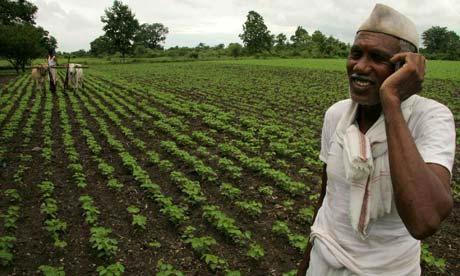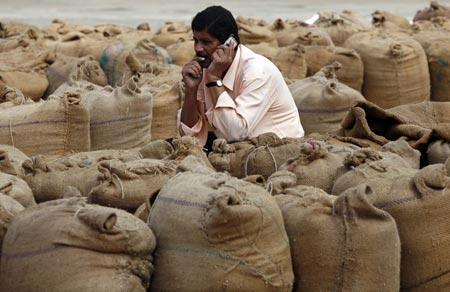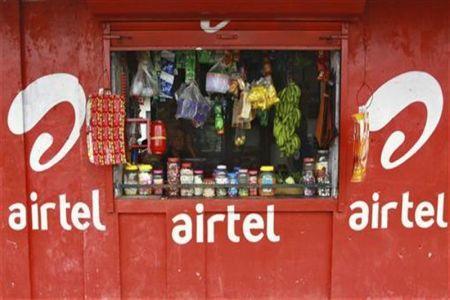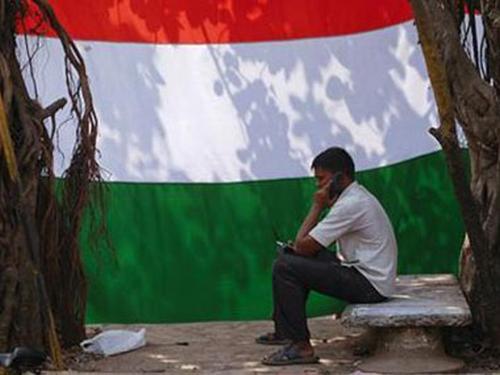Photographs: Krishnendu Halder/Reuters Subodh Saxena and V Sridhar
The high cost of handsets is one of the reasons wireless broadband has not picked up in the country. But the government's recent notification to promote indigenous telecom manufacturing provides the right environment to seriously think about developing a low-cost 4G handset.
Despite the infamous scams and taints that the industry has faced, each Indian can claim to be a proud beneficiary of the country's telecom revolution.
More importantly, the sector's near $100-billion contribution to Gross Domestic Product has proved the link between telecom penetration and economic development. Where do we go from here?
Much like we leapfrogged the analog first-generation cellular mobile service in the nineties directly to second-generation digital mobile systems, to the benefit of users and operators alike, opportunities do exist today to usher in a wireless broadband revolution.
Broadband penetration in the country continues to slip behind targets, thanks to inadequate wire-line and wireless coverage.
Though the optic fibre projects funded through the Universal Service Obligation Fund to provide backhaul connectivity up to gram panchayat level is progressing, last-mile access is still a problem.
Wireless broadband as the access solution is the only viable alternative to achieve the desired target.
...
4G can bring the next telecom revolution
Photographs: Amit Dave/Reuters
Here is the opportunity for India to dream much like Sam Pitroda did in the eighties with the Centre for Development of Telematics (C-DoT).
C-DoT was mandated and delivered the Rural Automatic Exchange (RAX) - its flagship product - within 36 months with an investment of Rs 36 crore (Rs 360 million).
Using a public-private-partnership model, C-DoT RAXs revolutionised voice connectivity in rural and remote areas through its indigenously designed low-cost, easy-to-install and resilient product.
This when India was struggling with a teledensity of one phone per hundred population and hardly any phones in rural areas.
Though scarce radio spectrum was allocated for 3G and broadband wireless operators way back in 2010, the service roll-out as well as adoption are very poor so far. 3G technologies have matured and economies of scale do exist, but the ecosystem for broadband wireless service, or BWA (also known as 4G technologies) is still in its nascent stage.
The high cost of handsets is considered one of the primary reasons for BWA not being provided. However, the government's recent notification to promote indigenous telecom manufacturing provides the right environment to seriously think about developing a "Rs 3,650 wireless broadband phone in 365 days" (to extend the C-DoT analogy).
...
4G can bring the next telecom revolution
Photographs: Reuters
Why should we indigenise the device? First, with liberalisation of spectrum as notified in National Telecom Policy 2012, operators can potentially deploy broadband wireless technologies at various spectrum bands they possess - namely in 800, 900, 1,800, 2,100, 2,300 MHz and soon to be released 700 MHz with options to fall back to 3G/2G.
Though multiband and multimode chipsets have been announced by some of the multinational vendors, the initiative to manufacture such devices still lags.
A device that is designed to work across all these bands mimics cognitive radio that enables flexible spectrum use. We can be the pioneer in designing and manufacturing such a device, which will have worldwide appeal. The Indian market forms a true test-bed for validating such a device.
Second, we can use the "power of the software" that our information technology and research & development (R&D) industry has in putting our minds to developing a software designed radio device that provides the intended flexibility in managing the radio resource.
This device, with its minimalistic intelligence in hardware, reduces our dependency on imports and provides the most value addition.
Third, the security in vital infrastructure industries such as telecom is continuously debated and is also cited as one of the primary reasons for the recent notification that all government departments and agencies under its control will have to buy between 50 and 100 per cent of their total telecom requirement from local manufacturers.
...
4G can bring the next telecom revolution
Photographs: Tobias Schwarz/Reuters
There are cases of mobile phones without the mandated international mobile equipment identity number being used in the country, which makes it almost impossible to detect fraudulent use.
With broadband internet connectivity provided through mobile devices, such detection is becoming even trickier.
A device domestically designed and manufactured can potentially be devoid of this problem much to the satisfaction of the Ministry of Defence!
The market for such devices is huge worldwide. According to Global Mobile Suppliers Association, there are 85 commercial 4G networks in 45 countries. There are about 27 million active 4G subscribers in the world, which is expected to reach an astronomical 802 million in 2017.
Indian operators, though one of the limited early adopters of the time division duplexing version of the widely deployed 4G networking technology called long-term evolution, can potentially drive uptake if a suitable low-cost indigenous device is available.
Some of our top Indian software conglomerates measure up to competencies that match North American and European counterparts in designing state-of-the-art communication protocols, and providing comprehensive testing solutions.
...
4G can bring the next telecom revolution
Photographs: Reuters
Many of our firms provide R&D services in advanced mobile technologies to multinationals. It is the uncertainty and risk in dealing with Indian operators and governments that have possibly prevented them from investing.
On the contrary, it is expected that the three of the top five mobile handset vendors will be Chinese by 2014. Chinese vendors are able to leverage their strong position in the domestic Chinese market and expand to other regions.
Indigenous 4G devices will not only invigorate telecom manufacturing but will have a multiplier effect on other associated sectors such as electronic components, cameras, batteries, chargers, plastic/aluminum housings. This will also bring the latent product and design talent of our engineers to the forefront.
Some of the Indian feature phone manufacturers leveraged the unique structure of the Indian market to beat the multinational rivals in the dual/multi SIM (subscriber identity module), multi-mode 2G handsets. Now, it is time to do the same in the wireless broadband space. A joint partnership project that leverages our capabilities in academia, industry and government institutes is the need of the hour.
(Subodh Saxena was formerly part of the top management in major public and private telecom services providers in India, Indonesia and UAE; and V Sridhar works with Sasken Communication Technologies. These views are personal).







article